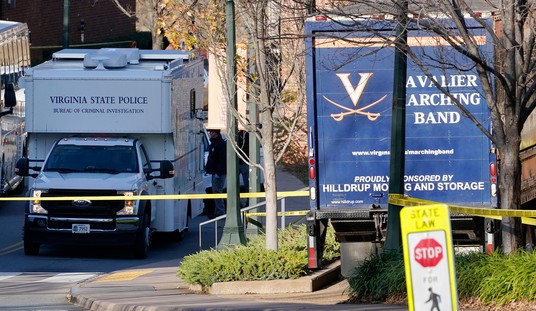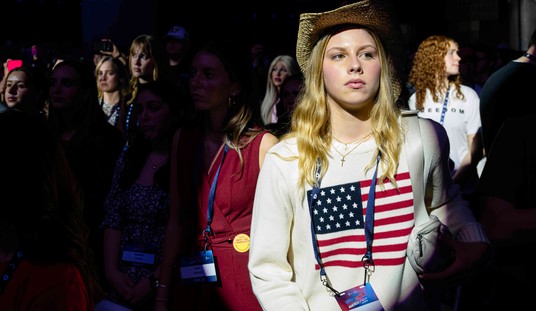Not surprisingly, Rep. Alexandria Ocasio-Cortez is on board with the protester-driven push to “defund police.” In an interview today on Good Morning America, host George Stephanopoulos pushed back on this slightly and at least one of his questions seemed to have caught AOC off guard.
Asked about Joe Biden’s refusal to go along with the “defund” effort, AOC didn’t criticize Biden directly but did say that New York City’s funding priorities were out of line with what residents want. She suggested that spending more on social programs would “prevent crime and social discord” from taking place.
Stephanopoulos pushed back a bit. “I understand the argument you’re making about expanding social services and investing in social services but the research does show that more police on the street means less crime,” he said.
“Well, I think there’s one question that is interesting here is that, when it comes to funds, it’s not always just about the number of officers in the street,” AOC said. She continued, “It’s about these police precincts that have tanks, that have military weaponry and frankly have a degree of—that have a degree of material resources and war-like weaponry that people ask ‘why does a local police precinct have this in the first place?'”
You may have noticed that she didn’t really answer the question. Stephanopoulos was pointing to evidence that increasing the number of police reduces crime. Monday I wrote about a Vox piece from 2019 which made this argument based on research in the criminal justice field:
In a 2005 paper, Jonathan Glick and Alex Tabarrok found a clever instrument to measure the effects of officer increases through the terrorism “alert levels” that were a feature of the early to mid-aughts. During high-alert periods, the Washington, DC, police force would mobilize extra officers, especially in and around the capital’s core, centered on the National Mall. Using daily crime data, they found that the level of crime decreased significantly on high-alert days, and the decrease was especially concentrated on the National Mall.
Critically, the finding was not that adding police officers leads to more arrests and then locking up crooks leads to lower crime in the long run. It’s simply that with more officers around, fewer people commit crimes in the first place. That seems to be the criminal justice ideal, in which fewer people are getting locked up because fewer people are being victimized by criminals.
That’s just a sample but it gives you an idea. And though it’s not spelled out, the corollary to this idea that more cops equal less crime is that fewer cops on the street probably results in more crime. More crime also means more victims of crime and more people involved in the criminal justice system.
Instead of addressing any of this, AOC tries to shift the conversation to police departments buying tanks. It’s true that some local police forces have purchase armored personnel vehicles like this BearCat purchased by a town in New Hampshire, but that money isn’t coming out of local coffers it’s coming in the form of grants from DHS.
The idea that police forces are blowing the city budget buying new tanks every year is misleading. In fact, when you actually look at the budget for the NYPD, which is nearly $6 billion per year, nearly all of that money goes to personnel costs.
At $5.9 billion in the current fiscal year, the NYPD has the third-largest budget of all city agencies after the Department of Education and Department of Social Services. It comprised about 6% of the city’s total $92.8 billion adopted budget for the current fiscal year (FY2020). Most of that police department funding comes from the city, with a few hundred million from state and federal grants…
It would be hard to significantly cut the NYPD’s budget without severely reducing its headcount. The city in 2015 added nearly 1,800 employees to the NYPD, including 1,300 new officers at the behest of the City Council.
According to an analysis by the Independent Budget Office, about 88.8% of the department’s adopted budget in Fiscal Year 2019 covered personnel services (salaries, wages and overtime) while 11.2% went to “Other than Personal Services” (OTPS) to fund purchase of supplies and equipment. Salaries and overtime for full-time employees – more than 36,000 uniformed personnel and about 15,500 civilian employees – covered nearly 75% of the budget. Planned overtime alone accounted for about 10% (or nearly $600 million) of spending that year while actual overtime spending was $730 million by the end of the fiscal year.
Notice first that the NYPD’s budget isn’t the largest one in the city. It comes after Education and Social Services, something that AOC failed to mention. She also fails to mention that it’s 6% of the total city budget.
The only way to significantly cut the police budget is to reduce overtime and reduce the number of officers. Both reductions will mean fewer officers on the street and, most likely, more crime, more victims of crime and more people involved in the criminal justice system. It would be great if someone would press AOC on how she plans to cut the police budget without cutting officers instead of allowing her to ramble about tanks.
Finally, the other thing AOC doesn’t mention is that the NYPD operating budget does not include the $5 billion per year the city spends on pensions contributions necessitated by fat union contracts. We could save a tremendous amount of money without taking any officers off the street by cutting back on those pension costs. Presumably AOC, as a leftist who believes unions are always good, would never support such cuts.








Join the conversation as a VIP Member